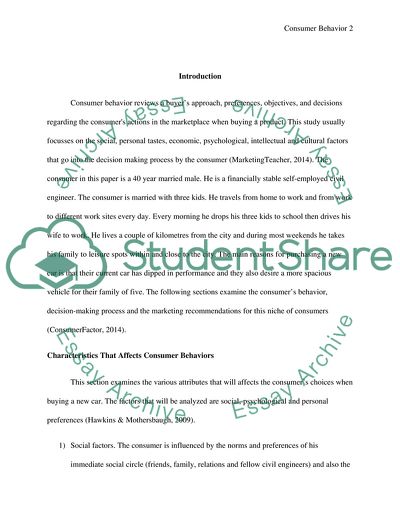Cite this document
(Buyer Decision-Making Process in Relation to Purchase of a New Car Coursework, n.d.)
Buyer Decision-Making Process in Relation to Purchase of a New Car Coursework. https://studentshare.org/marketing/1846142-imagine-you-work-for-a-company-that-manufactures-cars-you-have-been-asked-to-produce-a-report-that-explains-the-characteristics-that-affect-consumer-behavior-and-outline-the-consumer-decision-making-process-as-it-relates-to-a-consumer-who-is-replacing
Buyer Decision-Making Process in Relation to Purchase of a New Car Coursework. https://studentshare.org/marketing/1846142-imagine-you-work-for-a-company-that-manufactures-cars-you-have-been-asked-to-produce-a-report-that-explains-the-characteristics-that-affect-consumer-behavior-and-outline-the-consumer-decision-making-process-as-it-relates-to-a-consumer-who-is-replacing
(Buyer Decision-Making Process in Relation to Purchase of a New Car Coursework)
Buyer Decision-Making Process in Relation to Purchase of a New Car Coursework. https://studentshare.org/marketing/1846142-imagine-you-work-for-a-company-that-manufactures-cars-you-have-been-asked-to-produce-a-report-that-explains-the-characteristics-that-affect-consumer-behavior-and-outline-the-consumer-decision-making-process-as-it-relates-to-a-consumer-who-is-replacing.
Buyer Decision-Making Process in Relation to Purchase of a New Car Coursework. https://studentshare.org/marketing/1846142-imagine-you-work-for-a-company-that-manufactures-cars-you-have-been-asked-to-produce-a-report-that-explains-the-characteristics-that-affect-consumer-behavior-and-outline-the-consumer-decision-making-process-as-it-relates-to-a-consumer-who-is-replacing.
“Buyer Decision-Making Process in Relation to Purchase of a New Car Coursework”. https://studentshare.org/marketing/1846142-imagine-you-work-for-a-company-that-manufactures-cars-you-have-been-asked-to-produce-a-report-that-explains-the-characteristics-that-affect-consumer-behavior-and-outline-the-consumer-decision-making-process-as-it-relates-to-a-consumer-who-is-replacing.


